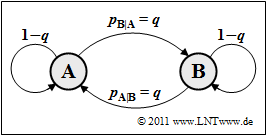Exercise 1.5Z: Symmetrical Markov Source
From LNTwww
(Redirected from Aufgabe 1.5Z: Symmetrische Markovquelle)
Exercise 1.5 dealt with a binary Markov source in which the transition probabilities from $\rm A$ to $\rm B$ and from $\rm B$ to $\rm A$ were different.
In this task, the following shall now apply:
- $$p_{\rm A\hspace{0.01cm}|\hspace{0.01cm}B} = p_{\rm B\hspace{0.01cm}|\hspace{0.01cm}A} = q \hspace{0.8cm} ( 0 \le q \le 1) \hspace{0.05cm}.$$
All equations given in Exercise 1.5 also apply here:
- Entropy:
- $$H = p_{\rm AA} \cdot {\rm log_2}\hspace{0.1cm}\frac {1}{ p_{\rm A\hspace{0.01cm}|\hspace{0.01cm}A}} + p_{\rm AB} \cdot {\rm log_2}\hspace{0.1cm}\frac {1}{ p_{\rm B\hspace{0.01cm}|\hspace{0.01cm}A}} + p_{\rm BA} \cdot {\rm log_2}\hspace{0.1cm}\frac {1}{ p_{\rm A\hspace{0.01cm}|\hspace{0.01cm}B}} + p_{\rm BB} \cdot {\rm log_2}\hspace{0.1cm}\frac {1}{ p_{\rm B\hspace{0.01cm}|\hspace{0.01cm}B}} \hspace{0.05cm}.$$
- First entropy approximation::
- $$H_{\rm 1} = p_{\rm A} \cdot {\rm log_2}\hspace{0.1cm} \frac{1}{p_{\rm A}} + p_{\rm B} \cdot {\rm log_2}\hspace{0.1cm} \frac{1}{p_{\rm B}} \hspace{0.05cm}.$$
- k–th entropy approximation $(k = 2, 3, \ \text{...})$:
- $$H_k = {1}/{k} \cdot \big [ H_{\rm 1} + (k-1) \cdot H \big] \hspace{0.05cm},\hspace{0.5cm}H = \lim_{k \rightarrow \infty } H_k \hspace{0.05cm}.$$
Hints:
- The exercise belongs to the chapter Discrete Sources with Memory.
- Reference is made in particular to the page "Binary sources with Markov properties".
- For all entropies, add the pseudo-unit "bit/symbol".
Questions
Solution
(1) For a stationary first order binary Markov source holds:
- $$p_{\rm A} = p_{\rm A\hspace{0.01cm}|\hspace{0.01cm}A} \cdot p_{\rm A} + p_{\rm A\hspace{0.01cm}|\hspace{0.01cm}B} \cdot p_{\rm B} = (1-q) \cdot p_{\rm A} + q \cdot p_{\rm B}$$
- $$\Rightarrow \hspace{0.3cm}q \cdot p_{\rm A} = q \cdot p_{\rm B} \hspace{0.3cm} \Rightarrow \hspace{0.3cm}p_{\rm A} = p_{\rm B}\hspace{0.15cm} \underline {= 0.5} \hspace{0.05cm}.$$
(2) To calculate the entropy $H$ one needs all four composite probabilities:
- $$p_{\rm AA} \hspace{0.1cm} = \hspace{0.1cm} p_{\rm A} \cdot p_{\rm A\hspace{0.01cm}|\hspace{0.01cm}A} = 1/2 \cdot(1-q) = p_{\rm BB}\hspace{0.05cm},\hspace{1cm} p_{\rm AB} \hspace{0.1cm} = \hspace{0.1cm} p_{\rm A} \cdot p_{\rm B\hspace{0.01cm}|\hspace{0.01cm}A} = 1/2 \cdot q = p_{\rm BA}\hspace{0.05cm}.$$
- Substituting these values into the given entropy equation, we get
- $$H = 2 \cdot \frac{1}{2} \cdot(1-q) \cdot {\rm log}_2\hspace{0.1cm} \frac{1}{1-q} + 2 \cdot \frac{1}{2} \cdot q \cdot {\rm log}_2\hspace{0.1cm} \frac{1}{q} = q \cdot {\rm log}_2\hspace{0.1cm} \frac{1}{q} + (1-q) \cdot {\rm log}_2\hspace{0.1cm} \frac{1}{1-q} = H_{\rm bin}(q) \hspace{0.05cm}.$$
- The numerical value sought is $H = H_{\rm bin} (0.25) \hspace{0.15cm}\underline{= 0.811 \, \rm bit/symbol}$.
(3) For equally probable binary symbols, $H_1 \hspace{0.15cm}\underline{= 1 \, \rm bit/Symbol}$.
- Using the equation valid for Markov sources, it further holds:
- $$H_2 \hspace{0.1cm} = \hspace{0.1cm} {1}/{2} \cdot \big[ H_1 + H \big] \hspace{0.15cm} \underline {= 0.906 \,{\rm bit/Symbol}} \hspace{0.05cm},$$
- $$ H_3 \hspace{0.1cm} = \hspace{0.1cm} {1}/{3} \cdot \big[ H_1 + 2 H \big] \hspace{0.15cm} \underline {= 0.874 \,{\rm bit/Symbol}} \hspace{0.05cm}.$$
(4) The maximum of the binary entropy function is obtained for $q\hspace{0.15cm}\underline{= 0.5}$.
- Thus the maximum entropy is $H = 1 \, \rm bit/symbol$.
- It can be seen from the relationship $H = H_1$ and from the transition diagram shown at the front that $q = 0.5$ results in statistically independent symbols:
- $$p_{\rm A} = p_{\rm A\hspace{0.01cm}|\hspace{0.01cm}A} = p_{\rm A\hspace{0.01cm}|\hspace{0.01cm}B} = 0.5 \hspace{0.05cm}, \hspace{0.2cm} p_{\rm B} = p_{\rm B\hspace{0.01cm}|\hspace{0.01cm}A} = p_{\rm B\hspace{0.01cm}|\hspace{0.01cm}B}= 0.5 \hspace{0.05cm}.$$
(5) Proposed solutions 1 and 2 are correct:
- The symbol sequence results either in $\rm AAAAAA$ ... or in $\rm BBBBBB$ ... , depending on which symbol was given as the starting value.
- The entropy of such a source is always $H = H_{\rm bin}(0) = 0$.
(6) Only proposed solution 3 is correct:
- Now neither $\rm A$ can directly follow $\rm A$ nor $\rm B$ can directly follow $\rm B$ .
- The result is always an alternating sequence, depending on the starting value the sequence $\rm ABABAB$ ... or $\rm BABABA$... .
- This source also has the entropy $H = H_{\rm bin}(1) = 0$ in both cases.
